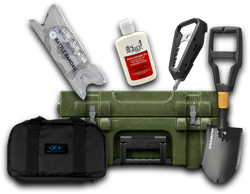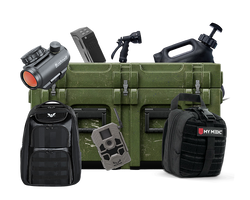
Tactical Medical Tips: Everything you need to know about your tactical medicine
When dealing with a tactical environment, you cannot rely on regular medical supplies since injuries under such conditions are critical. You need tactical medicine and specifically designed med kits to help treat those critical injuries. Not only is the equipment in these kits different, but the way to use them is also slightly different, which makes them more effective.
So, in this comprehensive guide, you will learn everything you need about tactical medicine kits.
Important contents to keep in your tactical med kits
Some basic contents of a tactical medical solution overlap with a first aid kit. So, whenever you are setting up your kit, ensure to have these in it:
- Sterile gloves
- Bandages
- Scissors
- Safety pins
- Alcohol wipes
- Gauze
- Tweezers
- Antiseptic ointment
- Medical tape
- CPR mask
Different types of medicines must be in your tactical medicine kit
The tactical medical solution is not only about the things listed in the previous section, but it must also have different types of medicines. These may vary depending on the person, but here are the 4 main types of medicines that must be in your tac medic kit.
1. Routine medicines
Start with routine medicines, also known as OTC medicines. These are easily available, and most tactical zones allow you to carry them. Since this kit is there to treat almost any injury or health problem, it must contain any medicine that you would need including:
- Pain killers
- Anti-allergy
- And other trauma-treating supplies.
2. Minor trauma and skincare medicines
One of the most common injuries faced during tactical situations is skin-related. These may include blisters due to harsh conditions or scratches or cuts on the skin. Such injuries are the most important to immediately cure since they can get infected. So, carry a supply of skin trauma medications, including ointments, wipes, eye irritation, and wound cleaning supplies.
3. Prescription medicines
When packing your kit, you must carry all the essential prescription medicines your physician suggests. The only exception is if the zone does not allow you to carry that medicine. Otherwise, carrying these is a must, along with aspirin and some analgesic drugs.
5. Ortho medicine
These are among the most important medicines you can keep in your tactical medic kit since ortho injuries are extremely common for tactical training personnel. Tapes, braces, and balms are most carried under this category, and you can also keep compression wraps along with cold packs and hot packs for instant pain relief.
Tips for using your tactical medicine
Since there are some differences between the tac medic kit and regular first aid kid, using it is also slightly different. You can follow the tips for better experience and efficiency when using the tac medic kit.
1. Always have the right plan and information.
You don’t get many chances when dealing with a critical tactical injury, and you must implement the medical solution with great precision. Starting right away and then getting confused midway is not the right option.
The best way to utilize a tactical medical solution is by having the right plan up your sleeve and treating the injury that way. That’s how you can ensure effective first aid for the critically injured person.
2. Working with partners is the best choice.
Whether injured or helping someone injured, you always prefer working with partners. When you are in a tactical situation, there will be many people around you who will be there to help you.
They will be available on your call, so you must call for them. It is extremely beneficial for self-treatment. Moreover, treating someone else will be beneficial since multiple minds and hands will get the job done quickly.
3. Don’t increase the size and weight too much.
You may be urged to pack things multiple times when setting up your tactical medical solution kit. It is important to understand that you only need this kit for immediate prehospital care, not a permanent solution.
Moreover, they will be available back at the base if you need more resources. So, always focus on the things that you need to do most. It is because packing with more weight will only make things harder for you.
4. Keep calm and focused during the treatment.
The last tip while using a tactical medical solution kit is to stay calm and focused. A critical tactical injury can be frightening or confusing, but you must stay calm and focused. Choose the right things and procedure for the treatment and calmly conduct it since not much could go wrong when treating the injured person.
If you maintain your focus on the treatment, you can be more efficient and give better prehospital care to the injured person.
The important thing to remember about your tactical med kits.
Even with the right medicine in your kid and all the tips mentioned above, so much could go wrong. For example, the first thing to remember about this kit is that your kit is for you, and only you can use it. If someone else is injured and you are helping them, use their kit.
Secondly, you must be careful about the placement of this kit since it must be easily accessible whenever you get injured. Moreover, you must place it in a way that does not interfere with your operation equipment or weapons. Lastly, it must look different from any other gear and pouches you have. That will make identification easier.
The Bottom Line
A regular first-air kit usually comes with the most basic supplies, and it fails when you need to heal a critical injury. That’s where tactical med kits will be helpful. These contain not only items from first aid kits but also tactical medicine.
Moreover, you have the choice to put any additional medicine that you may need during tactical situations. Hopefully, this guide has been helpful enough to teach you about maintaining, placing, and using your tac medic kit.
Share this article








